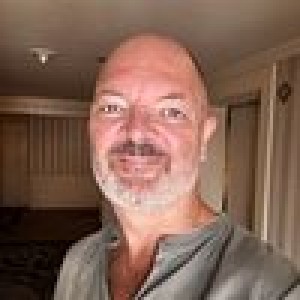Everest Base Camp Trek with Helicopter Return Highlights:
- Enjoy a panoramic helicopter flight from Gorekshep to Lukla.
- The adventure begins at the airport, one of the most challenging in the world.
- Explore the lively Sherpa city of Namche Bazaar in the Khumbu region.
- Visit the ancient Tengboche Monastery, surrounded by breathtaking mountain views
- Trek through this UNESCO-listed national park to see the diverse flora and fauna
- Khumbu Glacier on your way to Everest Base Camp.
- Standing at the base of the world's tallest peak, Mt. Everest
- Hike up to Kala Patthar for a close-up view of Everest and other Himalayan giants.
- Mount Everest, Lhotse, Nuptse, Ama Dablam, and other Himalayan peaks are visible.
- Finish your trek by taking a thrilling flight back to Lukla.
Everest Base Camp Trek with Helicopter Return 2025/26 Price
The Everest Base Camp (EBC) Trek with Helicopter Return—12 Days is a shorter and faster alternative to the classic Everest Base Camp trek, designed for travelers who want to experience the Himalayas but have limited time.
This thrilling adventure begins with a scenic flight to Lukla, followed by a memorable trek through charming Sherpa villages and breathtaking landscapes leading to Everest Base Camp (5,364 m) and Kala Patthar (5,545 m) for the best panoramic views of Mount Everest.
After completing the trek, you’ll enjoy a helicopter flight from Gorak Shep or a nearby point back to Lukla before returning to Kathmandu. This itinerary perfectly combines the excitement of trekking with the comfort and luxury of an aerial return, saving valuable time on the descent while still offering the full beauty and adventure of the Everest region.
Everest Base Camp Trip with a helicopter return Trek surpasses your imagination of exploring the alpine Khumbu region's diversities of nature and culture. This adventurous Himalayan journey covers the major attractions of the alpine Sherpa valleys and the flora and fauna of the Sagarmatha National Park and offers breathtaking snowy pinnacles.
The trip becomes much more enticing once you avoid all the downhill steps by taking a shared helicopter ride back from Kalapatthar to Lukla, which is beneficial for saving your time and energy. The trek to Everest Base Camp is rich with its unique culture and ethnicity. Sherpa villages like Namche Bazaar and Khumjung are rich in spirituality and history, with many cultural monuments and monasteries.
The Everest Base Camp Trail allows trekkers to acclimatize by hiking in the surrounding area. This helps them discover rich cultural facts. Cultural vibes inspire and motivate you to finish the journey to Everest Base Camp.
As you enter Sagarmatha National Park, the views of the grassy land and glacial terrain will amaze you. Mountain goats, preserved especially, often greet trekkers. The Himalayan scenery is a treat for wandering spirits with positive vibes.
The rocky terrain is visible above 5000 meters as you cross the glacier. Everest Base Camp and Kalapatthar can be seen on the other side. The sight of the humongous peaks such as Mount Everest (8,848 meters), Lhotse (8,848 meters), Makalu (Ama Dablam), and other nearby summits is a truly overwhelming experience.
The best season for the Everest Base Camp Trekking with Helicopter The return trip includes spring and autumn to witness the magical mountains and enticing surroundings. Often the days become warm and favorable to walking. However, these are quite crowded seasons.
To customize the helicopter for the Everest Base Camp trip and return schedule, contact Adventure Club Trek. We operate the trek with our professional team of guides and porters. Another exciting adventure in the Everest region is the Everest Base Camp Trek with Helicopter Return, available in various durations to suit your schedule and preferences.
These treks perfectly blend the breathtaking beauty of the Himalayas with the comfort of a helicopter return, allowing trekkers to save time while enjoying stunning aerial views of Mount Everest and surrounding peaks. Popular options include the Everest Base Camp Trek with Scenic Helicopter Return (11 Days), the Everest Base Camp Trek with Helicopter Return (10 Days), and the Everest Base Camp Trek and Helicopter Return (9 Days)—each offering an unforgettable Himalayan experience.
To book your trip:
Booking the Everest Base Camp trek with a helicopter return for 12 days is simple. Just let us know your preferred date and share your details to confirm your booking. We can help you choose the right time for your trip. You can reach out to us via email or phone through social media, as mentioned below.
For 24/7 direct assistance, call Mr. Birendra at +977-9851025658 (WhatsApp and Viber).
You can also contact us via email at [email protected].
For instant booking, click the Book Now
Alternatively, visit our Contact Us page. Click Here
Why choose to walk when you can fly back?
The Everest Base Camp Trek now offers a helicopter return from Gorakshep to Lukla. Experiencing the Himalayas from above and tracing the familiar route adds a whole new extent to the journey. The aerial perspective of the majestic Himalayan range is nothing short of awe-inspiring, amplifying the significance of the Everest adventure. Following a night's rest in Lukla, where time can be spent leisurely and discovering the town's charm, the trek culminates in a helicopter flight to Kathmandu the next day, completing the Everest Base Camp experience in an exhilarating and memorable way.
When is the best time for an EBC trek with helicopter return?
The best time for the helicopter trek to Everest is from March to May and mid-September to the end of November. Most days during this time of year are clear, with fabulous views of peaks and Mt. Everest. March to May falls from spring to pre-summer, when days are longer with enough sunlight for views to enjoy the mountain panorama. However, days can get windy and cloudy sometimes in the afternoon, even snowy in higher elevations. Around this time, the hills are lively with wildflowers blooming with riots of colors, especially the rhododendron (the national flower of Nepal). Mid-September to the end of November is another best time for the Base Camp Tour, as most days are clear with stunning views of the peak. However, the temperature can sometimes drop to the freezing point.
How Difficult is the EBC Trek with Helicopter Return
The Everest Base Camp Trek with a helicopter The return from Gorak Shep can be considered a moderate trek. Some travelers find it to be an easy trek. The only problem you will face is the high altitude. Everest Base Camp Trekking has the most increased accessibility, except for parts such as Tengboche, Thugla Pass, and the Lobuche-Gorak Shep moraine trek along Khumbu Glacier. You'll be able to complete the Gorak Shep hike with our guides and two acclimatization breaks. You'll also fly back to Kathmandu or Lukla. You will get the best possible return on your Everest trek.
How to Prepare for the Everest Helicopter Return Trek?
Preparing well for the Everest Helicopter Return Trek is essential for a safe and successful journey. Since the trek involves several steep ascents and descents, it’s important to assess your fitness level beforehand. Begin training at least two months before departure, focusing on cardiovascular exercises and stamina-building workouts to improve endurance. Equally important is mental readiness. Trekkers with determination and a positive mindset can overcome the physical challenges of the trail. Proper acclimatization is also crucial to reduce the risk of altitude sickness and help your body adjust to the high Himalayan environment. Lastly, selecting the best season for the trek ensures favorable weather conditions and an overall enjoyable experience in the Everest region.
Permits Required for the Everest Base Camp Helicopter Trek
To trek in the Everest region, you must obtain two essential permits—the Khumbu Rural Municipality Permit and the Sagarmatha National Park Entry Permit. These are mandatory for the Everest Base Camp Helicopter Trek. A Trekkers’ Information Management System (TIMS) Card is not required for this route.
The Khumbu Rural Municipality Permit costs NPR 2,000 per person and must be paid in Nepalese Rupees (NPR) at the entrance checkpoint.
The Sagarmatha National Park Entry Permit fee depends on nationality:
Foreigners: NPR 3,000
SAARC nationals: NPR 1,000
Nepali citizens: NPR 100
Children below 10 years old do not require a permit. This permit can be obtained either at the Nepal Tourism Board office in Kathmandu or directly at the park’s entry point.
Accommodation on 12-Day EBC Trek with Helicopter Return
Adventure Club Trek will provide the best teahouse for your 12 days on the Everest Base Camp Helicopter Trek. Up to Namche Bazaar, you'll receive a twin-sharing room with an attached bathroom. After Namche Bazaar, you'll be accommodated in neat, clean rooms where you can expect thoroughly washed bedsheets and pillowcases. You'll get clean blankets and cozy spaces for overnight accommodations.
Meals on 12-Day EBC Trek with Helicopter Return
The Everest Base Camp Trek with Helicopter Return offers the best food at each teahouse. We will serve you delicious meals on this trek until Gorak Shep and back to Lukla on the last night of this trek in the Himalayas. You can enjoy Nepali and Western dishes for breakfast, lunch, and dinner.
Breakfast: Breakfast can include toast, bread, omelets, honey and butter, oatmeal, chapatis, muesli cereals, beans, coffee, tea, hot milk, or lemon ginger tea.
Lunch and Dinner: You can choose from various dishes for lunch and dinner, including dumplings with vegetables, fried rice with a tuna or omelet sauce, pizzas, burgers & sandwiches, steaks, Tenduk with cooked vegetables, and spaghetti.
Drinking-Water EBC Trek with Helicopter Return
Adventure Club provides all the meals on the trek but needs to provide water. The best option is to treat the local water with chlorine/iodine tablets or a SteriPen. The teahouses will give you good-quality free water, and you can also get it along the trail, but you will need to treat it. If you are using the tablets, make sure they dissolve completely (about 30 mins). On most treks, you can buy mineral water along the trail. A liter of mineral water at lower-elevation tea houses costs around USD 1, but at higher elevations can cost up to $4, so the cost can add up.


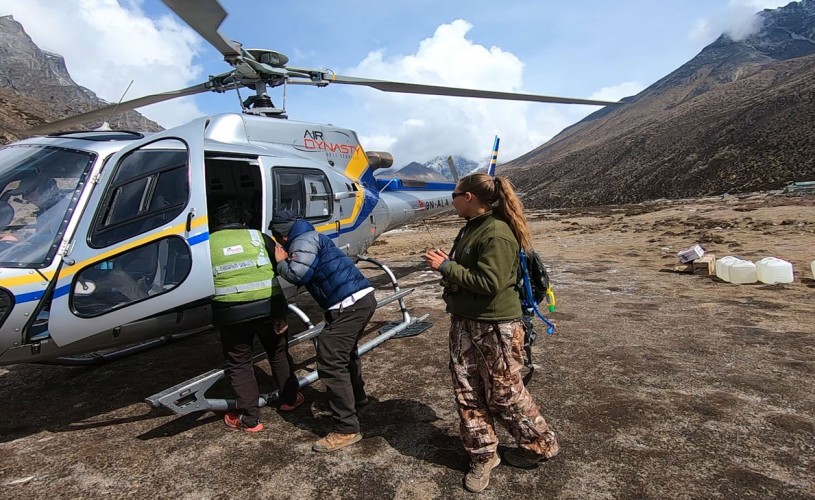
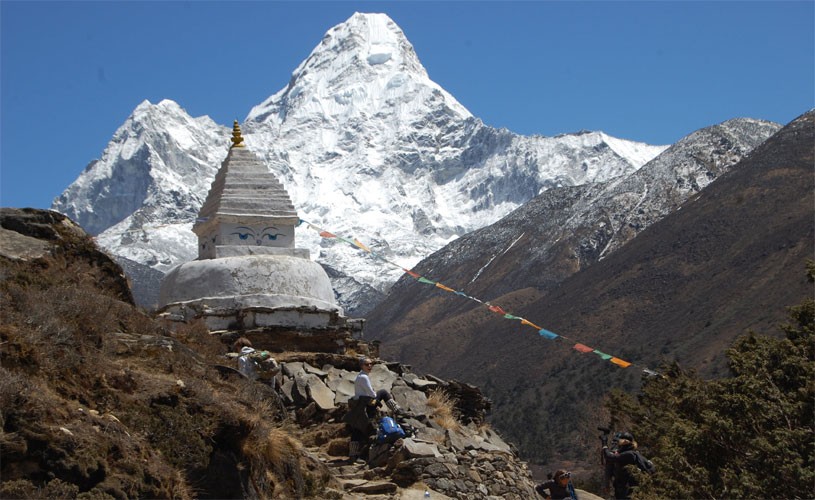
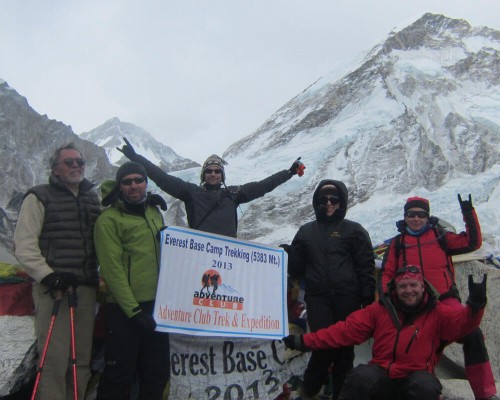

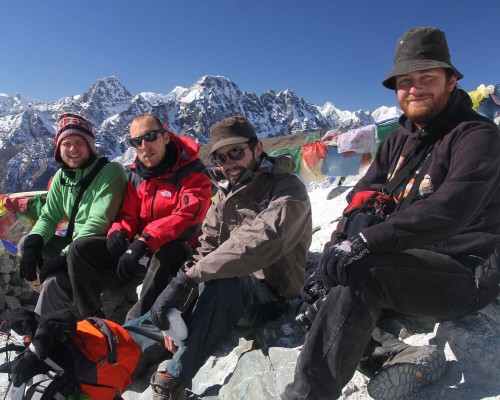
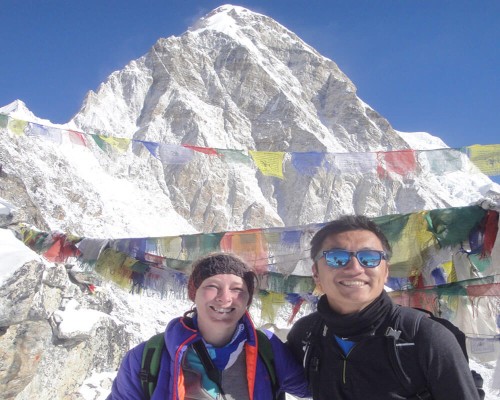
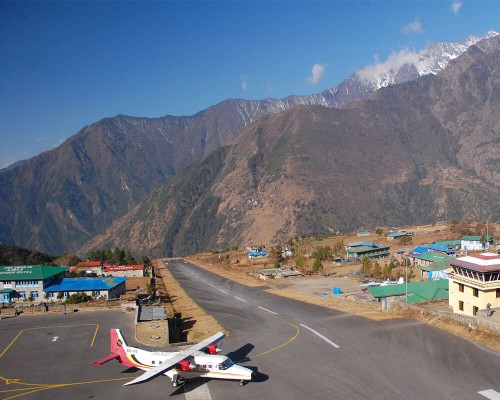


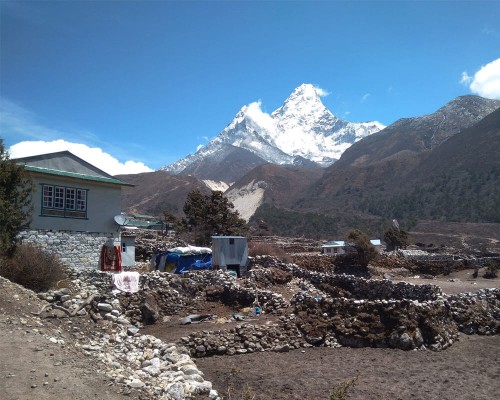
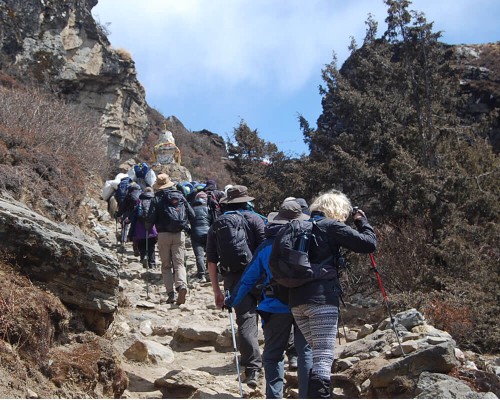
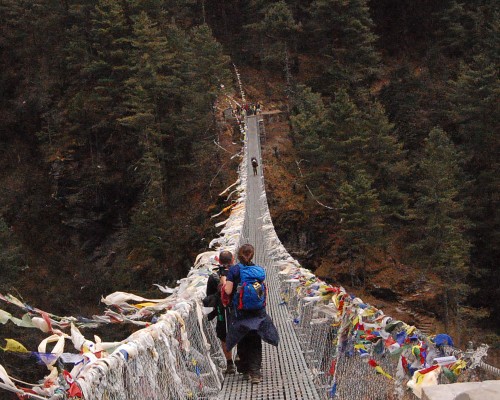


.jpg)

